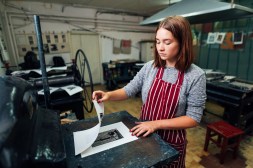Crafting Your Future: The Journey of Transforming into a Professional Artist
Becoming a professional artist involves more than just creating beautiful artwork; it’s a journey that demands dedication, passion, and ongoing growth. It’s about refining your skills, developing a robust portfolio, and navigating the art industry. If your dream is to make a living from your art, here are some essential steps to guide you on your journey.
Developing Your Craft
To become a professional artist, you must first focus on developing your craft. This involves mastering the fundamental techniques and principles of art. Take the time to study different artistic styles and mediums to find what resonates with you.

Start by taking art classes or workshops to learn from experienced artists. Experiment with various materials and techniques to discover your unique style. Remember that practice makes perfect; spend hours refining your skills and pushing yourself outside of your comfort zone.
Additionally, seeking feedback from other artists or joining an art community can provide valuable insights and help you grow as an artist. Embrace constructive criticism as an opportunity for improvement.
Building Your Portfolio
A strong portfolio is crucial for any aspiring professional artist. It showcases your body of work and demonstrates your artistic ability to potential clients or galleries. When curating your portfolio, aim for quality over quantity.
Select pieces that represent different aspects of your artistic style and versatility. Include both finished artworks and sketches that showcase your creative process. Consider organizing your portfolio around themes or series to create a cohesive narrative.
Remember to keep updating your portfolio regularly as you create new works or improve existing ones. This shows growth and progression in your artistic journey over time.
Navigating the Art Industry
Navigating the art industry can be challenging but essential for becoming a professional artist. Start by researching galleries, exhibitions, competitions, or online platforms where you can showcase and sell your artwork.
Establishing connections with fellow artists, art collectors, and industry professionals can open doors for collaborations and opportunities. Attend art events, workshops, and networking events to expand your network.
Building an online presence is also crucial in today’s digital world. Create a website or portfolio that showcases your work, and engage with potential clients or art enthusiasts through social media platforms. Use relevant hashtags and join online communities to gain visibility.
Continuous Growth and Learning
Becoming a professional artist is not a destination but an ongoing journey of growth and learning. Stay curious and open-minded by exploring new artistic styles, attending workshops or masterclasses, or experimenting with different mediums.
Seek inspiration from various sources such as nature, other artists’ works, books, or even everyday life experiences. Keep pushing yourself outside of your comfort zone to challenge your artistic boundaries and evolve as an artist.
Remember that setbacks are part of the journey. Embrace failures as learning opportunities and use them to fuel your determination to succeed. Stay committed to your craft and consistently create art that reflects who you are as an artist.
In conclusion, becoming a professional artist requires dedication, perseverance, and continuous growth. Focus on developing your craft, building a strong portfolio, navigating the art industry, and embracing continuous learning. Remember that the journey is just as important as the destination; enjoy every step along the way.
This text was generated using a large language model, and select text has been reviewed and moderated for purposes such as readability.


